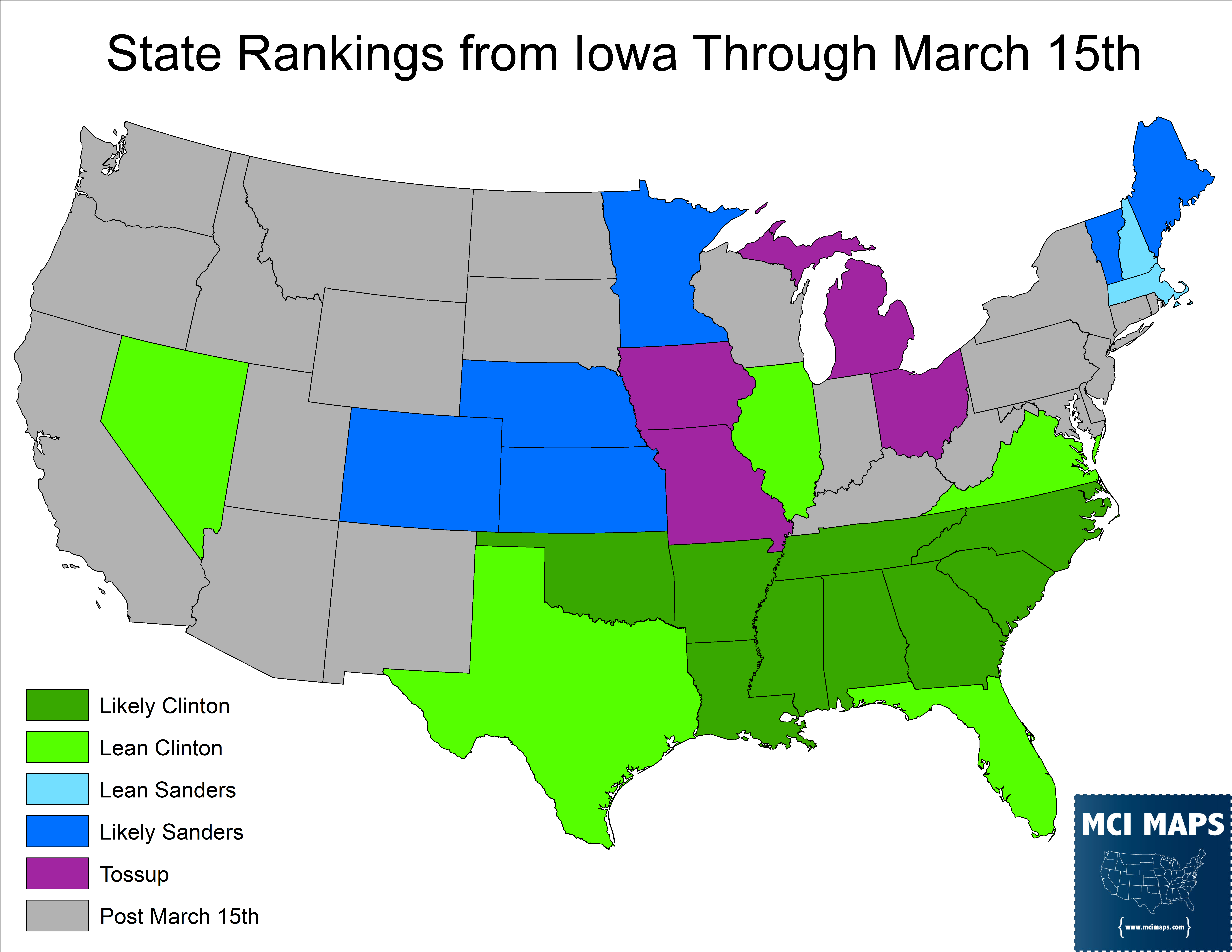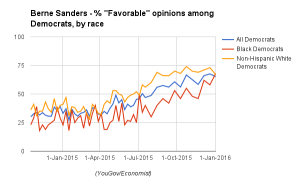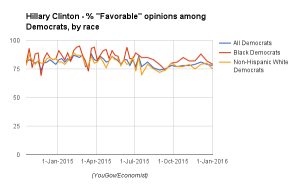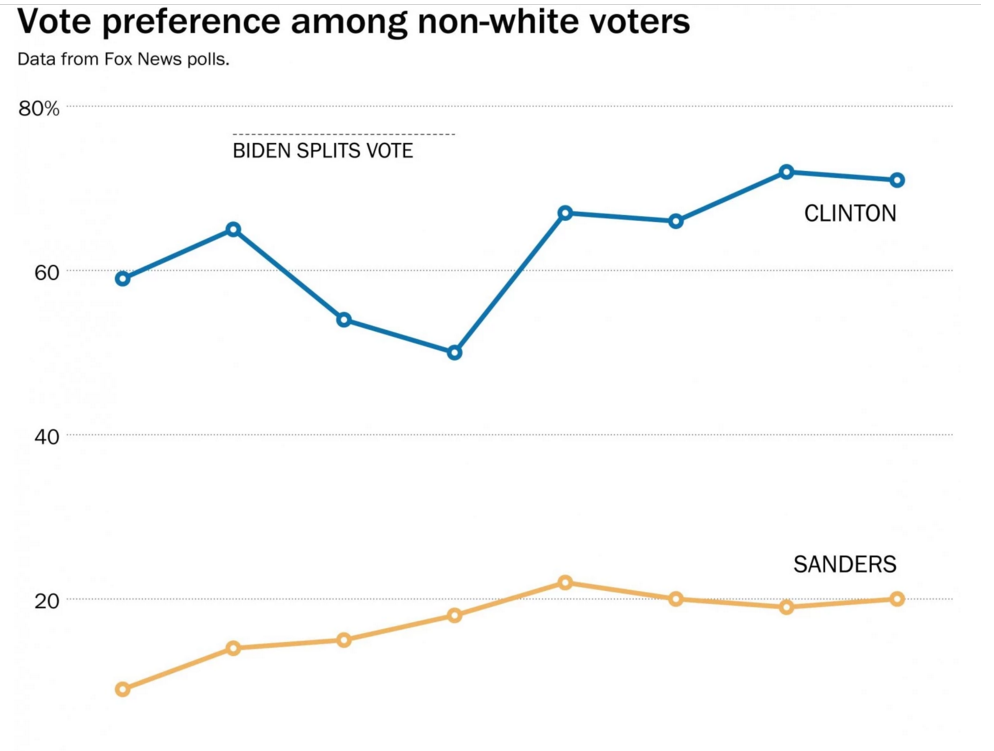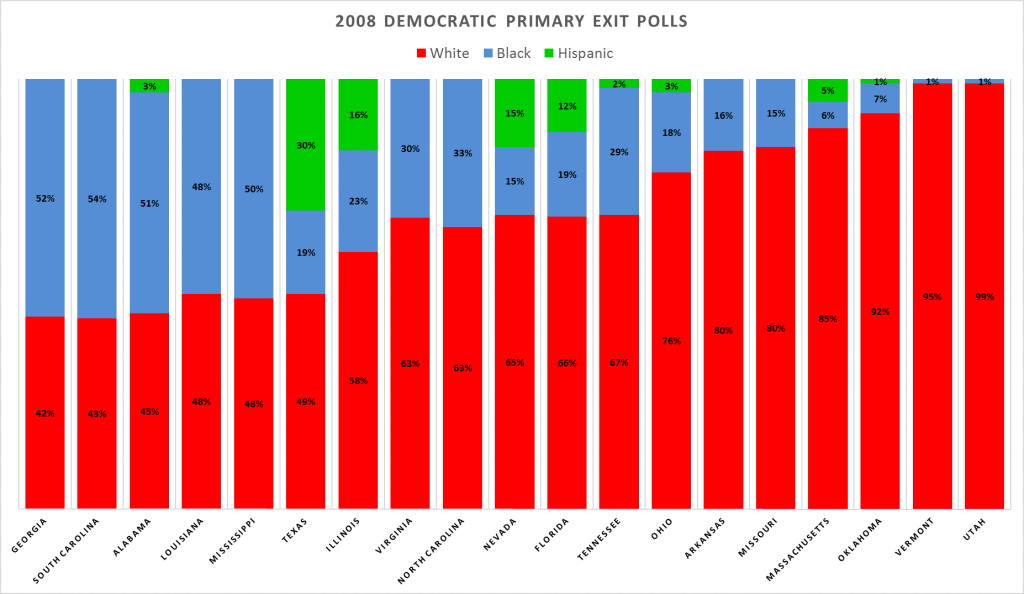With the Iowa caucuses one week away, coverage and poll releases for the Democratic Primary for President have reached a fever pitch. According to nationwide polling, Hillary Clinton maintains a double digit lead over liberal firebrand Bernie Sanders. However, polls in Iowa are neck and neck and Sanders leads in New Hampshire. The possibility of Sanders winning the first two states is real, as both are heavily influenced by white liberals, a key group of Sanders backers. However, past those states is where things shift more to Clinton’s favor… at least right now. This article will look at every primary state from Iowa to March 15, where several big states will vote on the same day, and assess who is likely to win based on current trends.
Methodology
At different points I will reference demographics from the 2008 primaries. These numbers were collected from CNN and the New York Times, and sometimes supplemented from other news agencies like ABC. Outside of the first 4 states, I will not reference any state-based polling. Polls in primary states over a month away or more cannot anticipate surges in candidates or shifts that are common in these primaries. In addition, polls in later states are few and far between, and many are several months old. In addition, while I will reference how Clinton and Obama did in 2008 with different groups, that is not me insinuating history will repeat itself. Some of Clinton’s white support, especially in the South, can be attributed to race, and Sanders, despite being more liberal, could do better with whites in states along the deep south. At the same time, contested GOP primaries in states with no party ID and open primaries could alter the ideological makeup of primary voters. In addition, Obama’s campaign likely increased African-American turnout beyond what it normally would have been in the primary season. However, with demographics continuing to shift in the south, it cannot be assumed the primary electorate will be any more or less white than in 2008. While some states may see nonwhite drop-off, some may even out thanks to growth in the nonwhite population, while some states will see an increase. 2008 exit poll data is meant to give an overall profile of the state, but it is not meant to be an exact calculation of support or demographic makeup.
Disclaimer and Note on Sanders v Clinton
It is no secret that I am supporting Hillary Clinton. I like Senator Sanders, but am very unhappy with the tone of the contest from supporters of both sides. Let’s get one thing clear: Sanders and Clinton are in agreement on essentially 90% of all issues. Sanders is the liberal firebrand; Clinton is the pragmatic progressive. Yes, Clinton has taken big money from big banks, so did Obama in 2008. Do I think Clinton is corrupted by this money? No, just like I don’t think Obama is corrupt. The other issue is this notion that Sanders is more electable. I was going to break this down but the Washington Post did it for me. Base point, January polls don’t tell you much, Sanders has been subject to little right-wing attacks, and approval and disapproval numbers can change pretty widely in a year. Just look at Obama’s approvals in December 2007, which are similar to where Clinton’s are now. Also, contrary to claims one must turn in their liberal card if you don’t back Sanders, the latest Monmouth poll has Clinton getting 42% of liberals to Sanders’ 51%. Sorry, but this author doesn’t buy the primary as some fight for the soul of the party. That said, the goal here is to push an honest assessment of the situation. I have no interest in inflating Clinton’s chances to only be proven wrong later.
The Current Dynamics
The current state of play between Sanders and Clinton influences these rankings. What we know is that Sanders has strong backing with young people, whites, and liberals. Clinton currently holds large leads with non-white voters, a major problem for Sanders in states after New Hampshire. Sanders has been making an aggressive push for the African-American vote. His approval has gone up significantly with African-Americans, but is still below Clinton’s. These charts are from Will Jordan of YouGov polling. Click the images for a larger view.
The big problem for Sanders is that while his favorability is up with non-white voters, it remains below Clinton’s, and in actual horse-race polls, Clinton maintains a commanding lead. This Washington Posts graph shows how the Clinton/Sanders horse-race has shifted among nonwhites.
Sanders needs to take from Clinton’s lead among nonwhites to have a shot past Iowa and New Hampshire. Unfortunately for Sanders, so far that has not happened. In fact, Monmouth’s latest poll showed a reverse trend, with Clinton increasing her lead with non-whites while losing more ground with white voters. The good news for Sanders is he still has voters who are learning about him and he’s closing ground or taking the lead with other groups. However, the drumming he is taking with nonwhites will be a problem in several states.
Another note is how liberals, moderates, and conservatives intend to vote. Sanders leads with liberals and trails with moderates and conservatives (here and here). However, all three groups view both candidates favorably. Sanders and Clinton have near equal net favorability with liberals, and Sanders is catching up to Clinton with moderates/conservatives. With both candidates essentially well-liked within the Democratic Party electorate, it is possible for these groups to shift as the primary season moves on. Clinton could regain a lead with liberals or Sanders could close the gap or win moderates (maybe not conservatives). The popularity of both candidates makes it possible for their support to shift quickly with either group as the primaries move on. These state rankings only reflect the current situation. That said, these rankings are not an “if the election were held today” scenario. These are assuming current support dynamics hold or remain similar but the Sanders campaign continues to gain support, especially among whites. For example: if the Ohio or Michigan primaries were held tomorrow, Clinton would clearly be favored. However, with those primaries so far out, its too early to say what may happen there, especially since whites dominate those primaries.
Iowa and New Hampshire
Iowa and New Hampshire are where Clinton hoped to start and end the primary season. However, Sanders has a realistic chance at winning both states. Both are heavily white and heavily influenced by liberal voters.
Iowa Caucuses
As of this writing, the Iowa caucuses are a virtual tie. Clinton led the state earlier in 2015, with Sanders seeing a surge to the lead in the early fall, followed by Clinton resuming a wide lead that has now evaporated. Clinton’s struggle in Iowa comes as a surprise due to recent polling but has long been seen by politicos as a potential problem for Clinton. In 2008, Clinton came in 3rd, and the caucuses heavy makeup of white liberal voters, a key group in Sander’s base, present a problem for Clinton. In 2008, liberals made up 54% of the participants, a group Clinton got 25% with compared to the 36-40% Obama got. In addition, Obama won first-time caucus goers 29-41, while the two virtually tied with previous attendees. A recent Iowa poll showed Clinton losing people planning to caucus for the first time 51%-41%, while leading previous attendees 51-42%. The poll actually indicates Clinton has made up a good bit of ground from 2008, with past caucus goers (the same people who rejected her before) backing her now. Clinton also is polling much higher now than she ever did in 2007/08. Clinton’s problem is she only has one viable opponent. In a split field she would likely win with 40 to 50%. Sanders’ base of young people and liberals reflects Obama’s, giving him a good chance to take the state from Clinton. Iowa’s caucuses have one of the youngest makeups in the primary, 22% under 30 and only 22% over 60. The latest polls show Sanders winning young voters while Clinton dominates with older voters. A win will no doubt boost Sanders as the press latch on to the story. The state’s liberal caucus and Clinton’s past troubles there will be glossed over in the name of sensationalism. Folks like Nate Silver will see it a logical move. Don’t get me wrong, it will be a big win for Sanders, one he really needs. For Sanders to have a shot past February, he needs big wins early. Iowa is first on the list. Rating: Toss-up
New Hampshire
Sanders’ fortunes in New Hampshire have looked good for months. Polling has been a little up and down, but it’s fair to say Sanders leads and may well lead by double digits. Part of this is no doubt due to being from neighboring Vermont. However, just as important is the makeup of New Hampshire’s primary, which is similar to Iowa, mainly composed of white liberals. 57% of the 2008 primary vote described themselves as liberal. In 2008, Hillary and Obama split near even on almost every ideology, very different from Iowa. The state’s primary became less of a liberal vs left of center fight in 2008 and Clinton famously trailed in polls but won convincingly anyway. The results prove the fluidity of the primaries and the ability of leads to change. If Bernie wins Iowa, he could see his lead expand, stay the same, or contract. It foolish to say for sure what will happen. New Hampshire will do its own thing. However, Bernie is better positioned to win this state than any other and he may well win it by a solid margin. Rating: Lean Sanders
Beyond Iowa and New Hampshire
Post Iowa and New Hampshire is where Sanders’ problems begin. Primaries after Iowa and New Hampshire are more diverse, an issue Sanders has had for months now. While Sanders’ approval with non-white voters has gone up significantly since he entered the race, non-white voters still prefer Clinton 65% to 20% and some even put it around 70% for Clinton. A key part of Obama’s coalition in 2008 was African-Americans. Hispanics stuck with Clinton through the primaries, but African-Americans backed Obama with over 70% of the vote. However, if Clinton maintainer her current support with minority groups, that will put many states she lost in 2008 into her column.
Momentum out of Iowa and New Hampshire could change things, but it is far from a guarantee. The Sanders’ campaign is working to grow its appeal with black voters, bringing out high profile endorsements of black leaders and scheduling a tour of historically black colleges. However, Sanders’ share of non-white voters has only nominally increased despite a large growth in approval among nonwhite voters. Again, this could change as later states pay closer attention, but right now nonwhite voters are still Clinton’s to lose. With that said, let’s look at the post Iowa and New Hampshire states with these racial dynamics in mind.
Nevada
In 2008, after Obama’s win in Iowa and Clinton’s win in New Hampshire, Nevada was seen as a potential tie breaker. Clinton had led polls by 5 to 10 points leading up to the caucuses, and she won the final vote by 6 points, 51% to 45%. Clinton won with white voters, who were 65% of the vote, 52% to 34%, and dominated with Hispanics (15% of the vote) 64% to 26%. Obama won an overwhelming 84% of African-American voters, who were an additional 15% of the primary. Clinton has led Nevada polls 50% to 30% but little polling has existed for the race. If Clinton’s support with Hispanics and African-Americans holds, it will help her with any erosion by whites. 45% of the caucus in 2008 said they were liberal, which includes African-Americans and Hispanics, indicating a white electorate less liberal than New Hampshire or Iowa. The makeup is also older, with 36% of the 2008 primary being older than 60 and only 13% under 30. Clinton was able to hold Nevada in 2008, and she may well hold it hear as well if Sanders’ appeal does not increase with non-white voters or he wins white voters comfortably. Ratings: Lean Clinton
South Carolina
In 2007, Clinton held a narrow lead in South Carolina, though well under 50%. Heading into the primary, Clinton led with white voters and was holding a respectable level of support with African-Americans. A Survey USA poll from December 2007 had Clinton at 39% of black voters to Obama’s 56%. However, when election day came Obama won 78% of black voters to Clinton’s 19%. Clinton didn’t benefit from the fact that John Edwards won white voters with 40%, 24% going to Clinton and 36% going to Obama. 44% of the voters in the primary regarded themselves as liberal. Currently, Clinton holds over 60% in the polls, thanks to a lead with African-Americans of 78% to 19%, and a 51% to 47% lead among whites. The white voters of the state are more moderate than in Iowa and New Hampshire, and Clinton should do well among them, even if she loses. Sanders needs a surge in African-American voters, who made up 54% of the 2008 primary, to have a chance in South Carolina. Sanders doesn’t need to win the state, but he can’t afford to get crushed in it either. A bad night thanks to a bad showing with African-Americans will fuel a media narrative the Senator does not want. However, if Sanders wins or comes close in South Carolina due to African-American support, it will give a major boost to his campaign. Rating: Likely Clinton
The March 1st SEC Primaries
Following the big 4, an 11 state and 1 territory primary will take place. The primary has been called the SEC primary due to it featuring many states from the SEC division in college football. Several deep south states with large African-American populations will be voting.
Minnesota Caucuses
There isn’t any real polling for 2016 or exit polls from 2008. Minnesota gave Obama over 66% of the vote in 2008 despite Clinton having the support of many establishment figures in the state. The caucuses got less attention as part of the 2012 Super Tuesday and this time find themselves lumped in with another Super Tuesday event. Sanders could very well win the caucuses which likely will have a high share of white liberals and benefits the candidate with the most enthusiastic fan-base. Rating: Likely Sanders
Virginia Primary
In 2008, the Virginia primary took place after Obama had established himself as having a serious shot at winning the Democratic nomination. Obama convincingly won the primary with 64%. Obama dominated with African-Americans, tied with whites, and won every age group. However, Clinton could have a good shot at winning in the state this time around. If Clinton holds her support with African-Americans, which make up 30% of the primary, she will likely win the primary. A big question will be how the white liberals of Northern Virginia, a constantly growing region, vote, considering many are federal employees. Obama won the northern suburbs in 2008 and 50% of the primary in 2008 was liberal. Obama also won every age group and ideology. A win for Sanders in Virginia is possible depending on how the Northern Suburbs and African-Americans go, but right now the demographics are more in Clinton’s favor. Rating: Lean Clinton
Vermont Primary
Obama won Vermont with 59% in 2008 and there is no doubt the state will go for Sanders in 2016. The win will be written off by the media. Rating: Safe Sanders
Arkansas Primary
Clinton got 70% in Arkansas in 2008 and it could easily be the same margin in 2016. Like Vermont for Sanders, a Clinton win here will be seen as a given. Rating: Safe Clinton
Alabama Primary
Obama won the Alabama primary in 2008 under a stark racial divide, getting 85% of African-Americans but only 26% of whites. African-Americans made up 51% of the primary in 2008 and if Clinton keeps strong support with that group then she is solid to win the state. The white voters of Alabama are much more conservative and not a prime group for Sanders to win. Sanders will likely only win the Alabama primary if he does well with African-American voters. One x-factor is the GOP primary on the same day and the state being open for anyone to vote for either primary. If more conservative whites defect to the GOP than they did in 08 (when the GOP race was already locked up) then that could erode support for Clinton. However, such a move could also increase the African-American share of the primary. Rating: Likely Clinton
Oklahoma
In 2008, Clinton got 55% in Oklahoma to Obama’s 31%. Edwards got 10% despite being out of the race. The electorate is over 90% white and older and more conservative. Over 42% of the 2008 primary was over 60, a group Clinton currently leads in by a large margin. The state has a large number of conservative Democrats and they are unlikely to back Sanders. I expect this state to go toward Clinton. Rating: Likely Clinton
Tennessee
Tennessee is another southern state with a mixture of African-Americans and white conservative voters. The African-American population was 29% of the primary in 2008, which Obama got 77% of. The white voters, meanwhile, gave Clinton 67%. Clinton’s lead with African-Americans would help her with any ground Sanders makes with white voters. Clinton got 54% of the vote in 2008 while losing the African-American vote overwhelmingly. She has the advantage in the state right now. Rating: Likely Clinton
Massachusetts
Massachusetts is a liberal mecca in the United States. The state should be good for Sanders, but it is notable that Clinton got 55% in 2008 and won every ideological group, including liberals, which made up 59% of the primary, 52%-46$. Elizabeth Warren has stayed on the sidelines, with reports being she is more inclined to endorse Clinton than Sanders. However, she is likely to stay out of the matter. Sanders should have an advantage in the state due to geography and ideology and I would venture he wins it comfortably. Rating: Lean Sanders
Georgia
Georgia went for Obama with 66% of the vote, one of his best showings in a southern state. He won 88% of African-Americans, which made up 52% of the primary, and only lost whites 39% to 57%. The primary was 47% liberal in 2008 and Obama’s share with white voters indicates that whites voting in the Dem side (the GOP had a primary as well that likely sucked up many conservative whites) were not as conservative as in some other states. This primary’s outcome will be largely effected by the African-American vote. With the non-white vote solidly in Clinton’s camp now, the state is likely to go to her. Rating: Likely Clinton
Texas
Texas will be the main event of the SEC primary. In 2008, the state was a high profile contest between Clinton and Obama. Clinton won the state 51% to 47% thanks to undecideds breaking her way in the last few days. The primary will feature a very diverse electorate — 49% white, 30% Hispanic and 19% African-American. Obama got 85% of the African-American vote but lost the other racial groups. Clinton’s 55% with whites and 63% with Hispanics allowed her the narrow win. Again, if the nonwhite vote holds for Clinton, she is strongly positioned to win the state even if Sanders eats into her support with white voters. However, only 37% of the primary voters in 2008 considered themselves liberal, and factoring in a portion of those being African-American and Hispanic, we are looking at a less liberal white electorate than other states. In 2008, Obama and Clinton were neck and neck with moderates, liberals and conservatives, so these groups could break either way. Rating: Lean Clinton
Post SEC Primary
Following the SEC primary, several states will hold elections that Thursday, Saturday, and the following Tuesday.
Kansas and Nebraska Caucuses
I am combining the Kansas and Nebraska caucuses as the dynamics for both are similar. Obama got 74% of the vote in Kansas and 68% in Nebraska. The nature of the caucuses gives the advantage to the candidate with the most active and motivated base. Right now, Sanders has a dedicated fan-base that could turn out in high numbers in a low turnout caucus. Considering neither state will be major battlegrounds on March 5th, the advantage shifts to Sanders thanks to his liberal, dedicated base, a similar dynamic that propelled Obama to his 2008 wins in the states. Ratings: Likely Sanders
Louisiana Primary
Similar to several other southern states, the African-American vote, which was 48% of the 2008 primary and propelled Obama into a 57% win, is likely to benefit Clinton this time around. Clinton only got 13% of the African-American vote while getting 57% of the white vote. Sanders would need to get a decent share of the African-American vote or win the white vote by a large margin to have a shot. With a more conservative white vote and Clinton’s African-American lead in polls, Clinton is favored to win the state. Rating: Likely Clinton
Maine Primary
Similar to the other caucus states, Sanders is favored here due to his dedicated fan-base. No exit polls where done in 2008 when Obama won with 59%. Ron Paul came closer to winning Maine in 2012 than any other state thanks to his dedicated fan-base. I give the advantage to Sanders and his fans in this state. Rating: Likely Sanders
Mississippi Primary
Mississippi has the same dynamic as Alabama and Louisiana. The support among African-Americans, 50% of the primary, will likely decide the winner, and that makes Clinton the favorite there at the moment. Clinton got 72% of the white vote in 2008, which is more conservative. Sanders would need a better showing than Obama with whites and needs to improve with African-Americans for a shot at the state. Rating: Likely Clinton
Michigan Primary
Michigan will be the main event for March 8th. The state is hard to handicap right now. The 2008 primary only saw Clinton get 55% versus uncommitted delegates. I have been unable to find exit polls indicating the African-American share of the 2008 primary, but it should be at least 20%, if not more. The Flint water crisis has been a major news story in Democratic circles, and the mayor of the city just endorsed Clinton, however it is unclear how much effect this would have in more populated areas. Clinton has a strong base in the working-class white community, but that is another voting group that could shift as the nomination contest goes on. Sanders will need a win or strong showing to continue momentum into the next week. Rating: Tossup
Big State Super Tuesday
A week after Michigan and two weeks after the SEC primary will be the 2nd Super Tuesday of the primary schedule, a series of large states. For Sanders, this will be the moment of truth for his campaign. Sanders will need money and momentum to keep up in these higher turnout races where a dedicated fan-base isn’t enough. If Sanders has only scored caucus wins to this point, he may not have momentum for these states. However, if Sanders shocks in states like Michigan/Texas or does better than expected in the deep south states, he could have momentum.
North Carolina
First off is North Carolina, another deep south state that for Sanders to have a shot at he needs African-American voters. Obama got 56% in 2008 thanks to a crushing 91% of African-Americans and a respectably 36% of whites. The primary was 33% African-American in 2008. There are liberal pockets, and 40% considered themselves liberal in 2008. Obama’s solid win was thanks to winning liberals, moderates, and getting 42% of conservatives. Like other deep south states, Clinton starts off with a solid advantage due to her lead with African-Americans and moderates/conservatives. Rating: Likely Clinton
Illinois
In 2008, Illinois wasn’t even contested. Obama was always going to win it and got a solid 65%. However, the state’s diverse electorate make it a good pickup opportunity for Clinton. 23% of the vote was black and 16% Hispanic in 2008, and this was the only state where Obama won Hispanics, no doubt thanks to being the hometown candidate. There are liberal pockets, especially around universities and in Chicago. However, the demographics, her family ties to the state, and the size of the vote, favor Clinton for now. For Sanders, the issue will be spreading resources across several states on that same day, while Ohio could be a better bet. Rating: Lean Clinton
Ohio
Ohio could find itself the premier fight of the March 15th contests. 76% of the primary was white in 2008, compared to 18% African-American. The primary is also a little younger and less old, with the 2008 primary 16% under 30 and 23% over 60. Of course, Sanders needs to keep improving with middle-aged voters. Sanders could benefit from college campuses and disillusioned white democrats in the Rust Belt, who right now back Clinton. Clinton managed to win 53%-45% with 61% of whites but only 10% of African-Americans. If Sanders doesn’t get crushed with African-Americans and can take some Clinton white voters, he has a shot. Right now, there is too little info and momentum could dictate the result. Rating: Toss-up
Florida
The primary in Florida in 2008 was a unique affair. The state had jumped the line in the contests and as such, the campaigns were told not to campaign in the state. Clinton won 50% to Obama’s 33% based on name recognition, as Obama was still gaining ground. However, the demographics of Florida give an advantage to Clinton. In 2008, the African-American share was 19% and Hispanics were 12%. That Hispanic number could wind up higher this go around, which if Clinton maintains her Hispanic lead, will benefit her. Unsurprisingly, the 2008 primary was also older, only 9% under 30 and 39% over 60. If Clinton maintains non-white support and wins the older white retirees she will have a solid chance at winning Florida. Turnout shifts and how demographic allegiances shift are Sanders’ only shot at winning such a large state. One question will be how the Northern Dixiecrats vote. In 2008, many counties in the North went to John Edwards, whose campaign was already essentially dead after South Carolina. How some of these conservative Democrats that vote GOP in the fall will line-up be interesting. Rating: Lean Clinton
Missouri
In 2008, Missouri was neck and neck, with Obama getting 49% to Clinton’s 48%. Only 15% of the primary was black, which Obama got 75% of, while Clinton got 53% of whites to Obama’s 38%. It is hard to say how Missouri will play out this early on. The state has no party registration and is an open primary. More conservative whites could flock to the GOP primary the same day, leaving moderates and liberals. The flock of whites could also increase the African-American vote share, however this is just speculation. The winner could be decided by who campaigns there more or turnout dynamics on that day. Rating: Tossup
Conclusion
The findings in this article are no different than the summaries made by other news organizations and analysts. For Sanders to have a shot at the nomination, he needs to perform better with non-white voters. Early primary wins could give him a bounce, but the question will be if it is enough. Clinton leads non-whites with over 70% in most polls, this is not something that can be quickly reversed. That said, as Sanders goes on, his approvals with nonwhite voters have grown, making it possible for them to switch sides in the race. However, the danger for Sanders is white voters, who are moving more in his direction but still like Clinton, abandoning him if they worry his appeal with nonwhites could be a problem in the general election. With Clinton and Sanders overall liked by almost all groups in the party, there is the possibility for many shifts in allegiance. That said, as the dynamics stand right now, Clinton still is the favorite for the nomination thanks to the states that vote after Iowa and New Hampshire.

